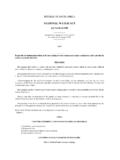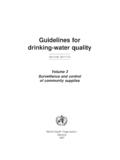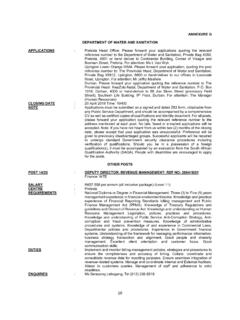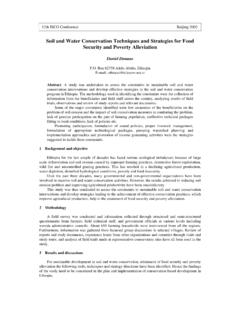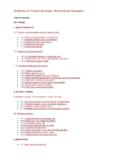Transcription of Water Safety Plans - who.int
1 WHO/SDE/ English only Water Safety Plans Managing drinking- Water quality from catchment to consumer Prepared by: Annette Davison, Water Futures, Dundas Valley, Australia, Guy Howard, DFID Bangladesh, United House, 10 Gulshan Avenue, Gulshan 1, Dhaka 1212, Bangladesh Melita Stevens, Melbourne Water , Melbourne, Australia Phil Callan, National Health and Medical Research Council, Woden, Australia Lorna Fewtrell, Centre for Research into Environment and Health, Aberystwyth, Wales Dan Deere, Water Futures, Dundas Valley, Australia Jamie Bartram, World Health Organization, Geneva, Switzerland Water , Sanitation and Health Protection and the Human Environment World Health Organization Geneva 2005 Water Safety Plans Managing drinking- Water quality from catchment to consumer World Health Organization 2005 The illustration of the cover page is extracted from Rescue Mission: Planet Earth, Peace Child International 1994; used by permission. All rights reserved. Publications of the World Health Organization can be obtained from Marketing and Dissemination, World Health Organization, 20 Avenue Appia, 1211 Geneva 27, Switzerland (tel: +41 22 791 2476; fax: +41 22 791 4857; email: Requests for permission to reproduce or translate WHO publications whether for sale or for noncommercial distribution should be addressed to Publications, at the above address (fax: +41 22 791 4806; email: The designations employed and the presentation of the material in this publication do not imply the expression of any opinion whatsoever on the part of the World Health Organization concerning the legal status of any country, territory, city or area or of its authorities, or concerning the delimitation of its frontiers or boundaries.))
2 The mention of specific companies or of certain manufacturers products does not imply that they are endorsed or recommended by the World Health Organization in preference to others of a similar nature that are not mentioned. Errors and omissions excepted, the names of proprietary products are distinguished by initial capital letters. The World Health Organization does not warrant that the information contained in this publication is complete and correct and shall not be liable for any damages incurred as a result of its use. Printed at the Printing and Binding Service WHO Geneva, Switzerland WHO information products on Water , sanitation, hygiene and health can be freely downloaded at: iContents LIST OF ABBREVIATIONS .. iv v 1 World Health Organization Guidelines .. 2 Current management approaches .. 5 The basis for Water Safety .. 6 Framework for Safe Drinking- Water and Water Safety Plans .. 6 , RESPONSIBILITIES AND LEGAL ASPECTS .. 13 Roles and responsibilities in the provision of safe drinking- Water .
3 13 Structure of the book .. 17 THE DEVELOPMENT OF Water Safety Plans 18 Commitment to the Water Safety plan approach .. 18 Development of a Water Safety plan .. 19 Assemble the Water Safety plan 20 Intended Water 22 Case studies .. 24 SUPPLY DESCRIPTION .. 29 Describe the Water supply .. 29 Construct flow 32 Confirmation of flow diagram .. 34 Melbourne Water case study abbreviated supply 35 Kampala case study abbreviated supply description .. 37 THE HAZARDS AND THREATS .. 38 Hazard identification .. 38 Hazardous 40 Prioritising 41 Melbourne Water case study hazard 43 Kampala case study hazard 45 MEASURES AND 49 Determine control measures .. 49 Melbourne Water case study control measures .. 54 Kampala Water case study control measures .. 56 AND 58 Monitoring parameters .. 59 Operational limits .. 60 61 Melbourne Water case study critical limits and monitoring .. 62 Kampala case study critical limits and monitoring.
4 63 66 Corrective actions and incident 66 Melbourne Water case study corrective actions and contingency measures .. 67 Kampala case study corrective actions and contingency measures .. 68 Emergency management procedures .. 70 76 Melbourne Water Case Study-Supporting Programmes .. 76 Kampala case study supporting programmes .. 76 AND RECORD KEEPING .. 78 Documenting the Water Safety plan .. 78 Record keeping and 79 Melbourne Water case study - documentation .. 80 Kampala case study - documentation .. 81 AND 82 Validation .. 82 84 Melbourne Water case study - validation .. 86 Kampala case study validation and 87 ASSESSMENT, UPGRADING SYSTEMS AND NEW SUPPLIES .. 89 Assessing an existing system against health-based targets .. 89 Using the risk assessment data for investment .. 92 Preparing a Water Safety plan for new supplies .. 92 Safety Plans FOR SMALL 95 Prioritising 95 Small system approaches.
5 96 Developing generic technology Water Safety Plans .. 97 Guides to aid local development of Water Safety Plans .. 110 Safety PLAN REVIEW, APPROVAL AND AUDIT .. 116 Introduction .. 116 Implementation, human resources and documentation .. 117 Evaluating the system assessment .. 118 Hazardous 120 Evaluating control measures .. 121 Monitoring and established 122 Corrective 123 Documentation and reporting .. 123 Validation and 124 Verification 124 Audit .. 124 AND COST 126 126 Cost 129 REFERENCES AND BIBLIOGRAPHY ..133 APPENDIX A: EXTRACTS FROM THE GOLD COAST Water .(GCW) Water QUALITY MANAGEMENT SYSTEM .. 137 APPENDIX B: MODEL Water Safety Plans .. 184 APPENDIX C: SANITARY INSPECTION FORMS .. 225 iv Acknowledgements Thanks go to Melbourne Water (Australia), Gold Coast Water (Australia), National Water and Sewerage Corporation (Uganda), Public Health and Environmental Engineering Laboratory, Department of Civil Engineering, Makerere University (Uganda) and the Water , Engineering and Development Centre, Loughborough University (UK), for their helpful assistance in providing examples for the text.
6 Specific thanks are due to David Smith, Sarah Tibatemwa, Charles Niwagaba, Sam Godfrey, Alan Godfree and Roy Kirby. List of abbreviations ADWG Australian Drinking Water Guidelines BWSA Bulk Water supply agreement CT Concentration x time (disinfection) DFID Department for International Development (UK) GCW Gold Coast Water (Australia) GDWQ Guidelines for Drinking- Water quality GL Giga litres HACCP Hazard Analysis and Critical Control Point HPC Heterotrophic Plate Count HU Hazen Unit ISO International Organization for Standardization MAK Makerere University (Uganda) MW Melbourne Water (Australia) NHMRC National Health and Medical Research Council (Australia)
7 NTU Nephalometric turbidity unit NWSC National Water and Sewerage Corporation (Uganda) O&M Operation and maintenance OSUL Ondea Services Uganda Limited (Uganda) PHAST Participatory health and sanitation transformation SCADA Supervisory control and data acquisition SOP Standard operating procedure USEPA United States Environmental Protection Agency WEDC Water , Engineering and Development Centre (UK) WHO World Health Organization WQCD Water Quality Control Department (Uganda) WSP Water Safety plan vForeword The first World Health Organization (WHO) publication dealing specifically with drinking- Water quality was published in 1958 as International Standards for Drinking- Water .
8 It was subsequently revised in 1963 and in 1971 under the same title. In 1984-85, the first edition of the WHO Guidelines for Drinking- Water Quality (GDWQ) was published in three volumes: Volume 1 Recommendations; Volume 2 Health Criteria and other Supporting Information; and Volume 3 Surveillance and Control of Community Supplies. The second editions of the three volumes of the Guidelines were published in 1993, 1996 and 1997, respectively. Addenda to the first and second volumes were published in 1998, addressing selected chemicals only. An addendum on microbial aspects reviewing selected microorganisms was published in 2002. The primary aim of the GDWQ is the protection of public health. The GDWQ provide an assessment of the health risk presented by microorganisms, chemicals and radionuclides present in drinking- Water . The guideline values recommended for individual constituents of Water are not mandatory limits they are intended to be used in the development of risk management strategies, including national or regional standards developed in the context of local or national environmental, social, economic and cultural conditions.
9 Such strategies, if properly implemented, will ensure the Safety of drinking- Water supplies through the elimination, or reduction to an acceptable concentration, of constituents of Water that are known to be hazardous to health. It was recommended in 1995 that the GDWQ undergo a rolling revision process. Through this process, microbes and chemicals are subject to periodic review, and documentation related to aspects of protection and control of drinking- Water quality is prepared progressively. This process was initiated at a meeting of the Coordinating Committee for the Rolling Revision of the GDWQ, at which three working groups (namely the Microbial Aspects working group, the Chemical Aspects working group and the Aspects of Protection and Control of drinking- Water quality working group) were established. The Coordinating Committee adopted the following: a plan of work for the development of the 3rd Edition of the GDWQ and their subsequent rolling revision; a plan of work for the development of supportive materials for implementation of the GDWQ; and a Procedures Manual for the conduct of the preparation of the third edition of the GDWQ and their subsequent rolling revision.
10 ViThe programme of work of the Microbial Aspects working group was adopted directly by the 1995 Coordinating Committee meeting. In its first phase of work, review documents on a number of specific microbes were prepared. A future strategy for major revision of the microbial aspects of the WHO Water -related guidelines, including the GDWQ, was also developed. The Chemical Aspects working group considered a wide range of different potential chemical contaminants classified broadly in relation to the source of contamination and the route to drinking- Water , in order to aid consideration of risk assessment and management options, as follows: naturally occurring chemicals (which include the majority of the most important chemical contaminants with regard to public health); chemicals from industrial sources and human dwellings; chemicals from agriculture; and chemicals used in Water treatment or materials in contact with drinking- Water .










